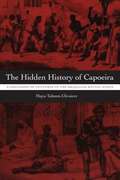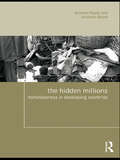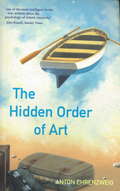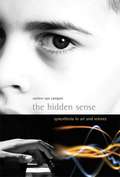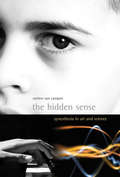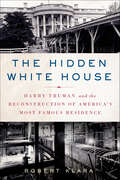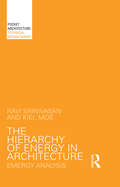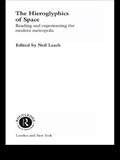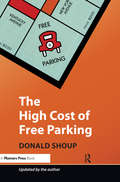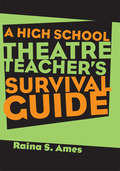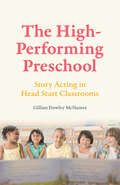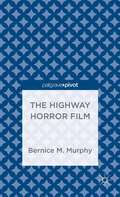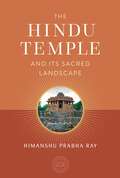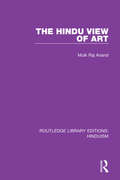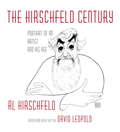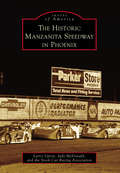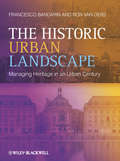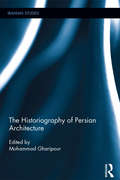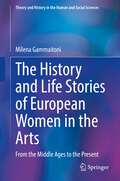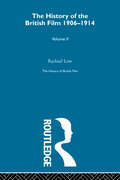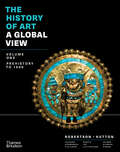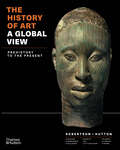- Table View
- List View
The Hidden History of Capoeira
by Maya Talmon-ChvaicerCapoeira, a Brazilian battle dance and national sport, has become popular all over the world. First brought to Brazil by African slaves and first documented in the late eighteenth century, capoeira has undergone many transformations as it has diffused throughout Brazilian society and beyond, taking on a multiplicity of meanings for those who participate in it and for the societies in which it is practiced. In this book, Maya Talmon-Chvaicer combines cultural history with anthropological research to offer an in-depth study of the development and meaning of capoeira, starting with the African cultures in which it originated and continuing up to the present day. Using a wealth of primary sources, Talmon-Chvaicer analyzes the outlooks on life, symbols, and rituals of the three major cultures that inspired capoeira - the Congolese (the historic area known today as Congo-Angola), the Yoruban, and the Catholic Portuguese cultures. As she traces the evolution of capoeira through successive historical eras, Talmon-Chvaicer maintains a dual perspective, depicting capoeira as it was experienced, observed, and understood by both Europeans and Africans, as well as by their descendants. This dual perspective uncovers many covert aspects of capoeira that have been repressed by the dominant Brazilian culture. This rich study reclaims the African origins and meanings of capoeira, while also acknowledging the many ways in which Catholic-Christian culture has contributed to it. The book will be fascinating reading not only for scholars but also for capoeira participants who may not know the deeper spiritual meanings of the customs, amulets, and rituals of this jogo da vida, "game of life. "
The Hidden Millions: Homelessness in Developing Countries (Housing and Society Series)
by Graham Tipple Suzanne SpeakThis book explores the extent, causes and characteristics of homelessness in developing countries. Bringing together a major review of literature and empirical case studies, it is invaluable for those studying, researching or working in housing, homelessness, social policy or urban poverty. Drawing on local research in nine countries in the global south, this book offers an insight into the lives of homeless people, public perceptions of homelessness, and the policies and interventions which might variously increase or reduce homelessness. Exploring the human context as well as policy and planning, it will challenge preconceptions.
The Hidden Order Of Art: A Study In The Psychology Of Artistic Imagination
by Anton EhrenzweigA revealing study into the relationship between psychology and the arts.Anton Ehrenzweig's tour de force describes nothing less than the psychology of artistic creativity. Focusing on the visual arts and music, he shows that, in addition to conscious, intellectual critical powers, both the child and the creative artist rely on an unconscious, intuitive critical process to give shape to their view of the world.
The Hidden Sense
by Cretien Van CampenWhat is does it mean to hear music in colors, to taste voices, to see each letter of the alphabet as a different color? These uncommon sensory experiences are examples of synesthesia, when two or more senses cooperate in perception. Once dismissed as imagination or delusion, metaphor or drug-induced hallucination, the experience of synesthesia has now been documented by scans of synesthetes' brains that show "crosstalk" between areas of the brain that do not normally communicate. In The Hidden Sense, Cretien van Campen explores synesthesia from both artistic and scientific perspectives, looking at accounts of individual experiences, examples of synesthesia in visual art, music, and literature, and recent neurological research. Van Campen reports that some studies define synesthesia as a brain impairment, a short circuit between two different areas. But synesthetes cannot imagine perceiving in any other way; many claim that synesthesia helps them in daily life. Van Campen investigates just what the function of synesthesia might be and what it might tell us about our own sensory perceptions. He examines the experiences of individual synesthetes -- from Patrick, who sees music as images and finds the most beautiful ones spring from the music of Prince, to the schoolgirl Sylvia, who is surprised to learn that not everyone sees the alphabet in colors as she does. And he finds suggestions of synesthesia in the work of Scriabin, Van Gogh, Kandinsky, Nabokov, Poe, and Baudelaire. What is synesthesia? It is not, van Campen concludes, an audiovisual performance, a literary technique, an artistic trend, or a metaphor. It is, perhaps, our hidden sense -- a way to think visually; a key to our own sensitivity.
The Hidden Sense: Synesthesia in Art and Science (Leonardo)
by Cretien Van CampenThe uncommon sensory perceptions of synesthesia explored through accounts of synesthetes' experiences, the latest scientific research, and suggestions of synesthesia in visual art, music, and literature. What is does it mean to hear music in colors, to taste voices, to see each letter of the alphabet as a different color? These uncommon sensory experiences are examples of synesthesia, when two or more senses cooperate in perception. Once dismissed as imagination or delusion, metaphor or drug-induced hallucination, the experience of synesthesia has now been documented by scans of synesthetes' brains that show "crosstalk" between areas of the brain that do not normally communicate. In The Hidden Sense, Cretien van Campen explores synesthesia from both artistic and scientific perspectives, looking at accounts of individual experiences, examples of synesthesia in visual art, music, and literature, and recent neurological research. Van Campen reports that some studies define synesthesia as a brain impairment, a short circuit between two different areas. But synesthetes cannot imagine perceiving in any other way; many claim that synesthesia helps them in daily life. Van Campen investigates just what the function of synesthesia might be and what it might tell us about our own sensory perceptions. He examines the experiences of individual synesthetes—from Patrick, who sees music as images and finds the most beautiful ones spring from the music of Prince, to the schoolgirl Sylvia, who is surprised to learn that not everyone sees the alphabet in colors as she does. And he finds suggestions of synesthesia in the work of Scriabin, Van Gogh, Kandinsky, Nabokov, Poe, and Baudelaire. What is synesthesia? It is not, van Campen concludes, an audiovisual performance, a literary technique, an artistic trend, or a metaphor. It is, perhaps, our hidden sense—a way to think visually; a key to our own sensitivity.
The Hidden White House: Harry Truman and the Reconstruction of America's Most Famous Residence
by Robert KlaraThe little-known story of the White House’s gutting and renovation during the Truman presidency: “Delightful and informative . . . plenty of entertaining drama.” —Publishers WeeklyIn 1948, President Harry Truman, enjoying a bath on the White House’s second floor, almost plunged through the ceiling of the Blue Room into a tea party for the Daughters of the American Revolution. A handpicked team of the country’s top architects conducted a secret inspection of the troubled mansion and, after discovering it was in imminent danger of collapse, insisted that the First Family be evicted immediately. What followed would be the most historically significant and politically complex home-improvement job in American history. While the Trumans camped across the street at Blair House, Congress debated whether to bulldoze the White House completely, and the Soviets exploded their first atomic bomb, starting the Cold War.Robert Klara reveals what has, until now, been little understood about this episode: America’s most famous historic home was basically demolished, giving birth to today’s White House. Leaving only the mansion’s facade untouched, workmen gutted everything within, replacing it with a steel frame and a complex labyrinth deep below ground that soon came to include a top-secret nuclear fallout shelter.The story of Truman’s rebuilding of the White House is a snapshot of postwar America and its first Cold War leader, undertaking a job that changed the centerpiece of the country’s national heritage. The job was by no means perfect, but it was remarkable—and, until now, all but forgotten.Includes photographs“Captivating . . . From bathtubs to bomb shelters, Klara leaves no piece of crumbling sandstone unturned and is as astute a storyteller as he is a dogged researcher.” —Denise Kiernan, New York Times–bestselling author of The Last Castle
The Hierarchy of Energy in Architecture: Emergy Analysis (PocketArchitecture)
by Ravi Srinivasan Kiel MoeThe laws of thermodynamics—and their implications for architecture—have not been fully integrated into architectural design. Architecture and building science too often remain constrained by linear concepts and methodologies regarding energy that occlude significant quantities and qualities of energy. The Hierarchy of Energy in Architecture addresses this situation by providing a clear overview of what energy is and what architects can do with it. Building on the emergy method pioneered by systems ecologist Howard T. Odum, the authors situate the energy practices of architecture within the hierarchies of energy and the thermodynamics of the large, non-equilibrium, non-linear energy systems that drive buildings, cities, the planet and universe. Part of the PocketArchitecture series, the book is divided into a fundamentals section, which introduces key topics and the emergy methodology, and an applications section, which features case studies applying emergy to various architectural systems. The book provides a concise but rigorous exposure to the system boundaries of the energy systems related to buildings and as such will appeal to professional architects and architecture students.
The Hieroglyphics of Space: Reading and Experiencing the Modern Metropolis
by Neil Leach'Spatial images', wrote the German cultural theorist, Siegfried Kracauer, 'are the dreams of society. Wherever the hieroglyphics of any spatial image are deciphered, there the basis of social reality presents itself.' But how exactly are these spatial images to be deciphered? Hieroglyphics of Space addresses this question with a series of insightful essays on some of the great metropolitan centres of the world. From political interpretations to gendered analyses, from methods of mapping to filmic representations, and from studies in consumption to economic surveys, the volume offers a range of strategies for reading and experiencing the modern metropolis.
The High Cost of Free Parking: Updated Edition
by Donald ShoupOne of the American Planning Association’s most popular and influential books is finally in paperback, with a new preface from the author on how thinking about parking has changed since this book was first published. In this no-holds-barred treatise, Donald Shoup argues that free parking has contributed to auto dependence, rapid urban sprawl, extravagant energy use, and a host of other problems. Planners mandate free parking to alleviate congestion but end up distorting transportation choices, debasing urban design, damaging the economy, and degrading the environment. Ubiquitous free parking helps explain why our cities sprawl on a scale fit more for cars than for people, and why American motor vehicles now consume one-eighth of the world's total oil production. But it doesn't have to be this way. Shoup proposes new ways for cities to regulate parking – namely, charge fair market prices for curb parking, use the resulting revenue to pay for services in the neighborhoods that generate it, and remove zoning requirements for off-street parking. Such measures, according to the Yale-trained economist and UCLA planning professor, will make parking easier and driving less necessary. Join the swelling ranks of Shoupistas by picking up this book today. You'll never look at a parking spot the same way again.
The High School Theatre Teacher's Survival Guide
by Raina S. AmesA reference for high school theatre teachers covering both curricular and extracurricular problems – everything from how to craft a syllabus for a theatre class to what to say to parents about a student's participation in a school play.
The High-Performing Preschool: Story Acting in Head Start Classrooms
by Gillian Dowley McnameeThe High-Performing Preschool takes readers into the lives of three- and four-year-old Head Start students during their first year of school and focuses on the centerpiece of their school day: story acting. In this activity, students act out stories from high-quality children’s literature as well as stories dictated by their peers. Drawing on a unique pair of thinkers--Russian psychologist Lev Vygotsky and renowned American teacher and educational writer Vivian G. Paley--Gillian Dowley McNamee elucidates the ways, and reasons, this activity is so successful. She shows how story acting offers a larger blueprint for curricula that helps ensure all preschools--not just those for society’s well-to-do--are excellent. McNamee outlines how story acting cultivates children’s oral and written language skills. She shows how it creates a crucial opportunity for teachers to guide children inside the interior logic and premises of an idea, and how it fosters the creation of a literary community. Starting with Vygotsky and Paley, McNamee paints a detailed portrait of high-quality preschool teaching, showing how educators can deliver on the promise of Head Start and provide a setting for all young children to become articulate, thoughtful, and literate learners.
The Highway Horror Film
by Bernice M. MurphyThe Highway Horror Film argues that 'Highway Horror' is a hither-to overlooked sub-genre of the American horror movie. In these films, the American landscape is by its very accessibility rendered terrifyingly hostile, and encounters with other travellers almost always have sinister outcomes.
The Hindu Temple and Its Sacred Landscape (The Oxford Centre for Hindu Studies)
by Himanshu Prabha RayThe Hindu Temple and Its Sacred Landscape explores Hinduism as it was practised in temples across the Indian subcontinent throughout history, highlighting the temple&’s significance as a marker of cultural identity.The Hindu Temple and Its Sacred Landscape illustrates how careful attention to the Hindu temple, its social history, and cultural landscape allows us to better appreciate how Hinduism has been practised and lived throughout history. The Hindu temple was not merely a place of worship or a static indicator of royal generosity but an institution that involved the active participation of the community for its establishment, maintenance, and survival. Rather than studying temples as isolated structures, The Hindu Temple and Its Sacred Landscape thus suggests that we need to examine them in the context of their social base and the sacred microcosms of which they form a part. Through a combination of textual study, archaeological evidence, and insights from contemporary anthropology, the book explores the diverse ways in which devotees, patrons, and visitors have engaged with temples, shrines, and their wider surroundings. Drawing attention to the vibrancy of the Hindu temple in different locales, The Hindu Temple and Its Sacred Landscape traces the ways in which Hindu notions of sanctity and sacredness were defined and redefined throughout history through the diversity of temple audiences, deities, and rituals. The book thus allows us to form a more accurate picture of Hindu religious life in the past and the central role the temple has played in consolidating Hindu identity. EXPERT ANALYSIS: Author Himanshu Prabha Ray provides authoritative analysis of the Hindu temple, drawing on her expertise as an award-winning Sanskrit scholar, historian, and archeologist. SUPPLEMENTAL STUDY: The Hindu Temple and Its Sacred Landscape provides a breadth of educational knowledge as a supplement to both academic coursework and the independent study of Hinduism. With the integration of discussion questions, suggested further reading, a glossary of key terms, and images throughout, The Hindu Temple and Its Sacred Landscape offers an accessible introduction to studying the history and significance of Hindu temples. EXPLORE THE SERIES: The Hindu Temple and Its Sacred Landscape expands the collection of academic texts developed by the Oxford Centre for Hindu Studies. Women in the Hindu World and The Bhagavad Gita: A New Translation and Study Guide are also available in the series.
The Hindu View of Art (Routledge Library Editions: Hinduism #3)
by Mulk Raj AnandThis book, first published in 1933, was the first text on the general Hindu attitude to art. It sums up under the wider title of the Hindu view of art all such considerations – religious, philosophic, sociological, aesthetic and technical – as might be helpful for the understanding of Indian art.
The Hirschfeld Century: Portrait of an Artist and His Age
by Al Hirschfeld David LeopoldI am down to a pencil, a pen, and a bottle of ink. I hope one day to eliminate the pencil. Al Hirschfeld redefined caricature and exemplified Broadway and Hollywood, enchanting generations with his mastery of line. His art appeared in every major publication during nine decades of the twentieth and twenty-first centuries, as well as on numerous book, record, and program covers; film posters and publicity art; and on fifteen U.S. postage stamps. Now, The Hirschfeld Century brings together for the first time the artist's extraordinary eighty-two-year career, revealed in more than 360 of his iconic black-and-white and color drawings, illustrations, and photographs--his influences, his techniques, his evolution from his earliest works to his last drawings, and with a biographical text by David Leopold, Hirschfeld authority, who, as archivist to the artist, worked side by side with him and has spent more than twenty years documenting the artist's extraordinary output. Here is Hirschfeld at age seventeen, working in the publicity department at Goldwyn Pictures (1920-1921), rising from errand boy to artist; his year at Universal (1921); and, beginning at age eighteen, art director at Selznick Pictures, headed by Louis Selznick (father of David O.) in New York. We see Hirschfeld, at age twenty-one, being influenced by the stylized drawings of Miguel Covarrubias, newly arrived from Mexico (they shared a studio on West Forty-Second Street), whose caricatures appeared in many of the most influential magazines, among them Vanity Fair. We see, as well, how Hirschfeld's friendship with John Held Jr. (Held's drawings literally created the look of the Jazz Age) was just as central as Covarrubias to the young artist's development, how Held's thin line affected Hirschfeld's early caricatures. Here is the Hirschfeld century, from his early doodles on the backs of theater programs in 1926 that led to his work for the drama editors of the New York Herald Tribune (an association that lasted twenty years) to his receiving a telegram from The New York Times, in 1928, asking for a two-column drawing of Sir Harry Lauder, a Scottish vaudeville singing sensation making one of his (many) farewell tours, an assignment that began a collaboration with the Times that lasted seventy-five years, to Hirschfeld's theater caricatures, by age twenty-five, a drawing appearing every week in one of four different New York newspapers. Here, through Hirschfeld's pen, are Ethel Merman, Benny Goodman, Judy Garland, Mickey Rooney, Katharine Hepburn, the Marx Brothers, Barbra Streisand, Elia Kazan, Mick Jagger, Ella Fitzgerald, Laurence Olivier, Martha Graham, et al. . . . Among the productions featured: Fiddler on the Roof, West Side Story, Rent, Guys and Dolls, The Wizard of Oz (Hirschfeld drew five posters for the original release), Gone with the Wind, The Sopranos, and more. Here as well are his brilliant portraits of writers, politicians, and the like, among them Ernest Hemingway (a pal from 1920s Paris), Tom Wolfe, Charles de Gaulle, Nelson Mandela, Joseph Stalin, Winston Churchill, and every president from Franklin D. Roosevelt to Bill Clinton. Sumptuous and ambitious, a book that gives us, through images and text, a Hirschfeld portrait of an artist and his age. From the Hardcover edition.
The Historic Manzanita Speedway in Phoenix (Images of America)
by Larry Upton Stock Car Racing Association Judy McdonaldPhoenix's Manzanita Speedway, the last of the big dirt tracks located near the central corridor of a major metropolitan area, is now gone. The track opened in the early 1950s when Jack Holloway, president of the Arizona Jalopy Racing Association, along with Avery Doyle and Gene Gunn, set about convincing Rudy Everett and Larry Meskimen to convert their unprofitable dog-racing operation into a quarter-mile dirt track. On August 25, 1951, Everett and Meskimen beamed with excitement as Manzy opened to an overflowing crowd. They had tapped into America's post-World War II craze for automobiles and found their own Lost Dutchman Gold Mine in the process. Manzanita Speedway dominated dirt-track racing in Phoenix and was heralded as one of the top five dirt tracks in the United States. Manzy became an integral part of the racing culture in Phoenix, and its sale and closure in 2009 created a sense of lingering disappointment.
The Historic Urban Landscape: Managing Heritage in an Urban Century (Creativity, Heritage And The City Ser. #2)
by Francesco Bandarin Ron van OersThis book offers a comprehensive overview of the intellectual developments in urban conservation. The authors offer unique insights from UNESCO's World Heritage Centre and the book is richly illustrated with colour photographs. Examples are drawn from urban heritage sites worldwide from Timbuktu to Liverpool to demonstrate key issues and best practice in urban conservation today. The book offers an invaluable resource for architects, planners, surveyors and engineers worldwide working in heritage conservation, as well as for local authority conservation officers and managers of heritage sites.
The Historical City. A Critical Reference and Role Model (The City Project #8)
by Ilaria Cattabriga Enrico Chinellato Arshia Eghbali Zeno Mutton Ramona LoffredoThis book offers a multivocal and interdisciplinary arena that brings together a wide range of thoughts and approaches addressing the intricacies of dealing with the historical city today. Spanning across a multitude of humanistic, sociological, and technological outlooks, it provides a multifaceted overview of current research on the city and its historicity. Based on revised and extended contributions presented at two international conferences, namely “The Historical City as a Critical Reference and Role Model for Innovative Urban and Metropolitan Development” (January 26-27, 2023) and “The Historical City as a Field for Critical Exercise. Criticism, Politics, Actors (April 17, 2023), both held at the University of Bologna, this book is an insightful and thought-provoking read for researchers in Architecture, History, Urban Studies, Social Sciences, and the Arts, as well as professionals and policy makers dealing with historical cities.
The Historiography of Persian Architecture (Iranian Studies)
by Mohammad GharipourHistoriography is the study of the methodology of writing history, the development of the discipline of history, and the changing interpretations of historical events in the works of individual historians. Exploring the historiography of Persian art and architecture requires a closer look at a diverse range of sources, including chronicles, historical accounts, travelogues, and material evidence coming from archaeological excavations. The Historiography of Persian Architecture highlights the political, cultural, and intellectual contexts that lie behind the written history of Persian architecture in the twentieth century, presenting a series of investigations on issues related to historiography. This book addresses the challenges, complexities, and contradictions regarding historical and geographical diversity of Persian architecture, including issues lacking in the 20th century historiography of Iran and neighbouring countries. This book not only illustrates different trends in Persian architecture but also clarifies changing notions of research in this field. Aiming to introduce new tools of analysis, the book offers fresh insights into the discipline, supported by historical documents, archaeological data, treatises, and visual materials. It brings together well-established and emerging scholars from a broad range of academic spheres, in order to question and challenge pre-existing historiographical frameworks, particularly through specific case studies. Overall, it provides a valuable contribution to the study of Persian architecture, simultaneously revisiting past literature and advancing new approaches. This book would be of interest to students and scholars of Middle East and Iranian Studies, as well as Architectural History, including Islamic architecture and historiography.
The History Of Photography
by Beaumont NewhallTraces the evolution of photography and offers vivid illustrations of technical innovations in this visual form of communication
The History and Life Stories of European Women in the Arts: From the Middle Ages to the Present (Theory and History in the Human and Social Sciences)
by Milena GammaitoniOffering historical identity fortified by the presence of women belonging to the various areas of creative and intellectual life, this book allows readers to understand greater contexts of their identity. The history of female artists is an indicator of how social identity was erased from the historiography which asserted itself in nineteenth-century Europe. Analysis of the biographical pathways traced here reveals how women in the Middle Ages and beyond have been active protagonists of the arts, received reviews, as well as had an authoritative role as the esteemed and attentive witnesses of the society around them.Reconstruction of social relationships, intellectual and creative production as well as of the life stories of some of Europe’s most important female artists, foregrounds this omission and highlights their extraordinary nature.The different stories contained in this book narrate the lives and works of Hildegard von Bingen, Francesca Caccini, Mary Wollstonecraft, George Sand, Lou Andreas Salomé and Elke Mascha Blankenburg.By reinforcing the awareness of social and historical origins, the informed reader is better equipped to tackle their futures and build up their personalities.
The History of British Film (Volume 2): The History of the British Film 1906 - 1914
by Rachael LowThis set is one of the cornerstones of film scholarship, and one of the most important works on twentieth century British culture. Published between 1948 and 1985, the volumes document all aspects of film making in Britain from its origins in 1896 to 1939.Rachael Low pioneered the interpretation of films in their context, arguing that to understand films it was necessary to establish their context. Her seven volumes are an object lesson in meticulous research, lucid analysis and accessible style, and have become the benchmark in film history.
The History of Art (Vol. Volume 1): Prehistory To 1500
by Rex Koontz Jean Robertson Ömür Harmansah Stacey Sloboda Deborah Hutton Cynthia Colburn Eric Kjellgren De-nin Lee Henry Luttikhuizen Allison Lee Palmer Monica Blackmun VisonàA more global, flexible way to teach art history The History of Art: A Global View is the first major art history survey textbook -- written by a team of expert authors -- with a global narrative in mind. A chronological organization and “Seeing Connections” features help readers make cross-cultural comparisons, while brief, modular chapters (with on-page definitions) offer instructors unparalleled flexibility. You can assign more than one chapter per week for a fully global course, or skip and reorder chapters, for a more focused syllabus.
The History of Art: A Global View: Prehistory to the Present (Vol. Combined Volume)
by Rex Koontz Jean Robertson Ömür Harmansah Stacey Sloboda Deborah Hutton Cynthia Colburn Eric Kjellgren De-nin Lee Henry Luttikhuizen Allison Lee Palmer Monica Blackmun VisonàA more global, flexible way to teach art history The History of Art: A Global View is the first major art history survey textbook -- written by a team of expert authors -- with a global narrative in mind. A chronological organization and “Seeing Connections” features help readers make cross-cultural comparisons, while brief, modular chapters (with on-page definitions) offer instructors unparalleled flexibility. You can assign more than one chapter per week for a fully global course, or skip and reorder chapters, for a more focused syllabus.
